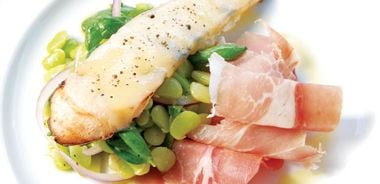Fava Bean Salad with Prosciutto and Warm Mozzarella Crostini

Buffalo mozzarella is an artisan gem, but do not be discouraged working this recipe through with other high-quality mozzarella. Just avoid cheaper versions with higher moisture contents.
3 cups (750 mL) fava beans, shelled and blanched (Remove the beans from the pod and blanch in boiling salted water for about 25 seconds. Drain and refresh in ice water.)
1 cup (250 mL) mint leaves, coarsely chopped or torn
1 cup (250 mL) basil leaves, coarsely chopped or torn
1/2 medium-sized red onion, thinly sliced
2 Tbsp (30 mL) lemon juice
4 Tbsp (60 mL) extra-virgin olive oil
Salt and black pepper to taste
150 g prosciutto, thinly sliced
1 large ball (1/2 to 1 lb/225-450 kg) buffalo mozzarella (or your favourite kind)
1/2 baguette
Extra-virgin olive oil for finishing
For the fava bean salad, toss all ingredients (except prosciutto, mozzarella, and baguette) together before serving and season to taste. Leave to come up to room temperature while you prepare crostini.
Thinly slice baguette on the bias into 12 pieces and toast in 350 F (180 C) oven until crisp and dry (about 3 to 5 minutes). Drizzle with olive oil and season to taste.
Slice mozzarella, divide amongst crostini, and return to oven until just warm (1 to 2 minutes). To assemble the dish, scoop a pile of fava bean salad onto each plate, dress with the prosciutto, and arrange a pair of crostini atop. Drizzle with olive oil and pepper if you like.
Serves 6.
source: "The Spirit of Café Brio", alive #308, June 2008




